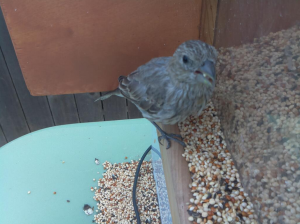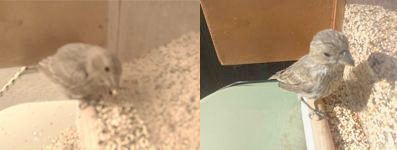| This is hands down the best bird feeder project we’ve seen yet. I got an email from the folks at Manifold, a creative design agency in San Francisco, this week. One of their developers works from Denver, Colorado, and has been spending some time building the ultimate bird table. It’s autonomous, it’s solar-powered, it feeds, it photographs, it tweets images when a bird comes to feed, and it’s open source. A PIR (passive infra-red) sensor detects when a bird lands at the table to feed, and triggers the camera. Photographs are then uploaded to Twitter. PIR’s a great choice here because it only responds to warm-body heat; if a leaf blows in front of the assembly, nothing will trigger, but if a toasty-warm little bird stops by for some seed, the sensor will detect it, and set off the camera. This was not a trivial build. Issues like waterproofing, power constraints, and all those fiddly annoyances you find with outdoor projects had to be dealt with. The prototype (built from the ground up out of bits of wood: no pre-made bird feeders for these guys) took around 25 hours to put together. Here’s a time-lapse video of what happened in the workshop. The first iteration of the Tweeter Feeder had a few bugs: the webcam in the assembly didn’t offer high enough resolution for decent pictures of the birds, and was swapped out with a Raspberry Pi camera board. But the camera board’s focal depth wasn’t right for this project, so an additional lens was put into the assembly – and then all the camera code had to be changed to reflect the switch. With cracking results: here’s a before and after picture. The PIR sensor was getting false positives from changes in temperature due to the sun on the feeder: an additional motion sensor was added to iron those out. A light sensor found its way into the assembly to stop the camera triggering when there wasn’t enough ambient light for a reasonable photograph. The solar panel positioning wasn’t optimal. And so on and so on – but the bugs have all been stomped now, and the end result is a thing of beauty. Read Chad’s account of what they were up to on Manifold’s blog (which has a ton of information on the development of the Feeder Tweeter), and then head to the Feeder Tweeter site itself, where there is an area for developers with a hardware list, wiring diagrams, links to all the code you’ll need on GitHub and much more. And let us know if you decide to make or adapt the Feeder Tweeter for your own use – we’d like to see what you come up with!
|
A Semi-automated Technology Roundup Provided by Linebaugh Public Library IT Staff | techblog.linebaugh.org
Friday, September 13, 2013
Feeder Tweeter
Subscribe to:
Post Comments (Atom)



No comments:
Post a Comment